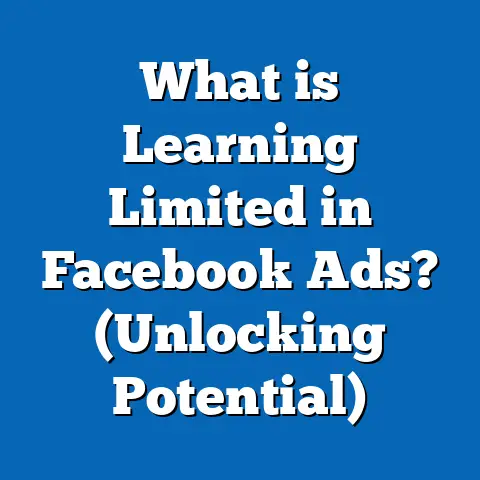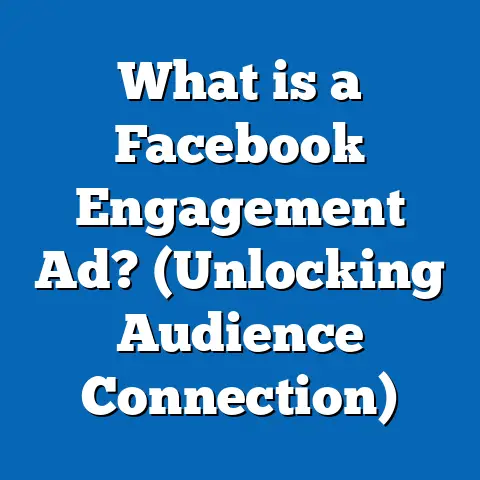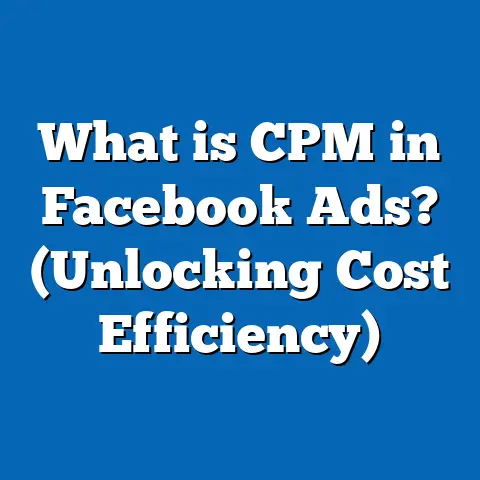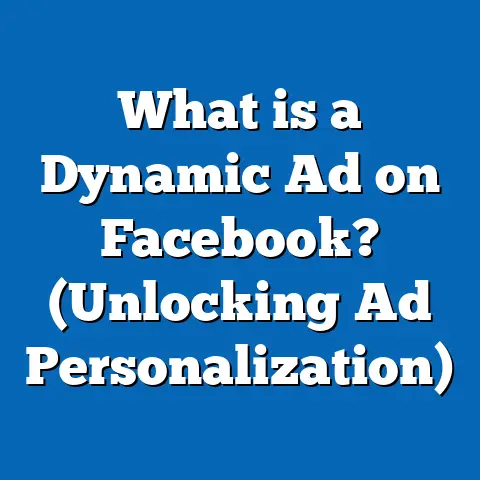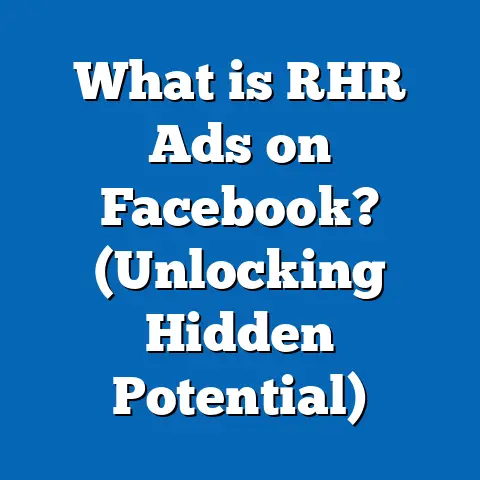What is the Ideal Audience for Facebook Ads? (Targeting Secrets)
What is the Ideal Audience for Facebook Ads? (Targeting Secrets)
Introduction: Why Finding the Ideal Audience Matters
Imagine spending thousands of dollars on Facebook ads only to see minimal engagement and poor sales. The frustration of wasted budget and missed opportunities is all too common. The difference between a failed campaign and a wildly successful one often boils down to one crucial factor: your audience.
Facebook Ads provide marketers access to over 3 billion users worldwide (Meta Q1 2024 report). But reaching everyone is neither possible nor effective. The secret lies in targeting the right people — your ideal audience. This group is most likely to resonate with your message, engage with your ad, and take the action you want.
When you find that audience, your campaigns become more efficient, your conversion rates improve, and your marketing budget stretches further. This guide will walk you step-by-step through everything you need to know about identifying and targeting your ideal Facebook ad audience—blending data, strategy, and proven methods for success in 2024.
Understanding the Concept of the Ideal Audience
What Does “Ideal Audience” Mean in Facebook Advertising?
The ideal audience is more than a vague notion; it’s a specific group defined by shared characteristics directly linked to their likelihood to respond favorably to your ads. These characteristics include:
- Demographics: Age, gender, location, language, education, income.
- Psychographics: Interests, values, lifestyle, attitudes.
- Behaviors: Online activity, purchase history, device usage.
- Engagement: Previous interaction with your brand or similar products.
For example, an online course selling digital marketing skills might discover its ideal audience is men and women aged 25-40 who have shown interest in entrepreneurship and online learning platforms.
Why Defining Your Ideal Audience is Crucial
Without a clear understanding of your ideal audience, your ad campaign becomes a scattergun approach—throwing money at a mass of people unlikely to be interested. Here’s why defining your ideal audience matters:
- Maximize Budget Efficiency: Ads are costly. Targeting only relevant users ensures every dollar serves a purpose.
- Higher Engagement Rates: When ads resonate with audience interests and needs, click-through rates (CTR) soar.
- Better Conversion Rates: Relevance leads to action—whether signing up, buying, or sharing.
- Improved Brand Loyalty: Engaging the right audience fosters long-term relationships.
- Reduced Ad Fatigue: Tailored ads minimize annoyance among uninterested users.
A study by WordStream found that targeted Facebook ads have a CTR 35% higher than untargeted campaigns, directly impacting ROI.
Facebook’s Audience Targeting Options: A Detailed Breakdown
Facebook offers an extensive toolbox of targeting options. Mastering these tools is essential for finding your ideal audience.
Core Audiences: Targeting Based on User Data
Core Audiences use Facebook’s vast user data to allow targeting by:
- Demographics: Age ranges from 13 to 65+, gender, languages spoken.
- Location: Country, state, city, postal code, or radius around a physical location.
- Interests: Pages liked, hobbies, topics followed.
- Behaviors: Purchasing habits, device type (iOS/Android), travel patterns.
- Connections: People connected to your Facebook page or event.
Example: A local café may target users aged 18-45 within a 5-mile radius who have interests in coffee or cafes.
Data Insight: According to Hootsuite (2023), interest-based targeting can improve engagement rates by up to 15%.
Custom Audiences: Retargeting Warm Prospects
Custom Audiences allow advertisers to reconnect with people who have already engaged with their business.
Sources include:
- Customer email lists or phone numbers.
- Website visitors tracked via Facebook Pixel.
- Users who interacted with your Facebook or Instagram content.
- App users tracked through Facebook SDK.
Why It Works: These audiences have shown some interest or familiarity with your brand, making them more likely to convert.
Stat: Retargeted ads have a conversion rate 70% higher than campaigns targeting cold audiences (AdEspresso, 2023).
Lookalike Audiences: Expanding Reach Smartly
Lookalike Audiences help you reach new people similar in behavior and traits to your best customers.
Facebook analyzes a source audience (such as a Custom Audience) and finds users with matching profiles.
Benefits include:
- Access to high-potential new customers.
- Scalable growth without losing precision.
- Ability to combine with other filters for refined targeting.
Case Study Insight: Facebook data shows Lookalike Audiences can increase conversion rates by up to 56%.
Data-Backed Insights on Audience Targeting Effectiveness
Demographic Targeting: The Foundation
Knowing who your customers are demographically forms the baseline of any campaign.
- Age & Gender: The largest user segment on Facebook globally is women aged 25-34 (Statista 2023).
- Location: Local targeting within a 10-mile radius can boost local business sales by up to 30%.
Marketers targeting specific age groups often see varying results:
| Age Group | Average CTR | Cost Per Click (CPC) |
|---|---|---|
| 18-24 | 1.6% | $0.45 |
| 25-34 | 1.8% | $0.50 |
| 35-44 | 1.5% | $0.55 |
Interest-Based Targeting: Aligning Ads with Passions
Targeting based on interests can significantly increase relevance.
Examples include fitness enthusiasts for workout gear or foodies for cooking classes.
Studies show interest-targeted ads outperform non-targeted ones by roughly 15% in engagement.
Behavioral Targeting: Pinpointing Actions
Facebook tracks behaviors like travel frequency, purchase history, and device use.
Targeting frequent travelers for luggage brands or tech gadget buyers for new devices yields better results.
According to a Salesforce report (2023), behavioral targeting increases conversion likelihood by nearly twice compared to generic targeting.
Custom Audience Retargeting: High ROI Strategy
Retargeting users who visited your website or engaged with previous ads has consistently shown:
- Increased CTRs (up to 3x compared to cold targeting).
- Reduced Cost per Acquisition (CPA).
Marketers see an average CPA reduction of 30%-40% when retargeting warm leads via Custom Audiences.
How to Identify Your Ideal Audience: A Step-by-Step Guide
Step 1: Analyze Your Current Customers
Start with what you know:
- Extract customer data from CRM systems or sales records.
- Identify common traits like age range, gender distribution, locations.
- Use Facebook Audience Insights for deeper analysis of followers or website visitors.
Example Persona:
Jane Doe
Age: 32
Location: Urban area
Interests: Yoga, organic food, wellness blogs
Purchase behavior: Buys wellness products online monthly
Step 2: Define Clear Campaign Objectives
Your ideal audience varies depending on whether you want:
- Brand awareness (broader reach).
- Lead generation (target warm prospects).
- Sales conversion (precise high-intent targets).
Align audience size and specificity accordingly.
Step 3: Leverage Facebook’s Data Tools
Tools like Audience Insights provide deep data on demographics, location, purchase behavior.
Facebook Pixel tracks user actions on your site—allowing retargeting based on behavior like abandoned carts or viewed products.
Step 4: Build and Test Different Audiences
Create multiple segments:
- Core Audience segment based on interests.
- Custom Audience from website visitors.
- Lookalike Audience from best customers.
Test performance of each segment against others using A/B split tests.
Step 5: Refine Based on Performance Data
Monitor key metrics such as:
- CTR
- Conversion Rate
- Cost per Result
- Frequency (to avoid ad fatigue)
Use this data for continuous improvement and scaling the most successful audiences.
Case Study Deep Dive: Eco-Friendly Skincare Brand’s Audience Discovery Journey
Business Context: Small skincare brand focused on sustainable ingredients struggling with low ROI on Facebook ads.
Initial Challenge: Broad targeting led to low engagement and high CPC ($2.50+).
Process:
- Conducted customer data analysis uncovering core buyers were women aged 28–40 interested in sustainability and natural products.
- Created Custom Audiences from website visitors who viewed product pages but didn’t purchase.
- Developed Lookalike Audiences from loyal customers’ email lists.
- Layered targeting combining demographic + interest + behavior filters.
- Tested ads across different segments using A/B testing tools.
Results After Three Months:
| Metric | Before Optimization | After Optimization |
|---|---|---|
| CTR | 0.9% | 1.28% |
| Cost per Acquisition | $2.50 | $1.55 |
| Monthly Sales | $8,000 | $16,000 |
This case highlights how targeted audience segmentation directly improves ad efficiency and business revenue.
Advanced Targeting Techniques & Strategies in Facebook Ads
Layered Targeting for Precision
Layer multiple filters for exact matches:
Example:
Women aged 30–45
- Interested in organic food
- Frequent online shoppers
- Located within urban areas
This layered approach reduces irrelevant impressions and improves ad relevance scores.
Exclusion Targeting Saves Budget
Exclude:
- Existing customers during acquisition campaigns.
- People who already converted.
- Irrelevant demographics or locations.
This ensures budget focuses on potential new customers only.
Dynamic Product Ads for E-commerce
Dynamic ads show personalized product recommendations based on user behavior.
This automated personalization increases conversion probability significantly.
Facebook reports that dynamic ads drive up to a 70% increase in purchases compared to static ads.
Comparing Facebook’s Audience Targeting with Other Advertising Platforms
| Platform | Targeting Strengths | Limitations |
|---|---|---|
| Extensive demographic/interest/behavioral options; custom & lookalike audiences | Limited visibility into some data sources; privacy impacts targeting granularity | |
| Google Ads | Intent-driven based on search queries; remarketing | Less social/behavioral insights |
| LinkedIn Ads | Professional targeting by job title/industry | Higher CPC; smaller audience size |
| TikTok Ads | Trend-focused younger audiences | Less mature ad platform; limited B2B options |
Facebook’s unique strength lies in combining deep social data with behavioral signals for versatile targeting across industries.
Latest Trends & Innovations in Facebook Audience Targeting (2024)
Privacy Changes Affecting Targeting
With global privacy laws tightening (GDPR, CCPA) and Apple’s iOS updates limiting data sharing:
- Facebook introduced Aggregated Event Measurement to track conversions while respecting privacy.
- Advertisers must adapt by focusing more on first-party data and contextual targeting.
AI-Powered Audience Recommendations
Facebook increasingly uses machine learning to suggest high-potential audiences based on campaign data in real-time—reducing manual guesswork.
Growth of Video & Engagement-Based Custom Audiences
Video consumption is rising sharply; marketers leverage video viewers as highly engaged Custom Audiences due to their demonstrated interest.
Such audiences often outperform traditional retargeting pools in engagement metrics.
Practical Examples & Real-world Applications
Example 1: Local Restaurant Campaign
Objective: Increase dine-in foot traffic within city limits.
Audience Setup:
- Location-based targeting within a 5-mile radius.
- Interests: Foodies, restaurant-goers, local events.
- Behaviors: Frequent dining out behavior identified by Facebook.
Result: A CTR increase of 28% compared to previous untargeted promotions and a measurable uptick in reservations.
Example 2: Online Clothing Store
Objective: Boost sales during seasonal sale event.
Audience Setup:
- Custom Audience from past purchasers within last six months.
- Lookalike Audience created from top-spending customers.
- Core audience targeting women aged 18–34 interested in fashion brands similar to theirs.
They layered exclusion of recent purchasers from acquisition ads to avoid redundancy.
Result: ROAS improved by 45%, cost per purchase decreased by 35%.
Common Mistakes When Choosing Your Facebook Ad Audience
- Too Broad Targeting: Leads to wasted spend and low engagement.
- Ignoring Retargeting: Missing out on warm leads reduces conversions.
- Not Testing Multiple Segments: Lack of testing means missed optimization opportunities.
- Overlooking Exclusions: Failing to exclude irrelevant groups inflates costs.
- Neglecting Data Analysis: Not monitoring campaign metrics leads to stagnation.
Avoid these pitfalls by following structured audience research and testing protocols outlined above.
Tools & Resources for Finding Your Ideal Facebook Ad Audience
Facebook Business Suite & Ads Manager
Central hub for creating audiences, managing campaigns, and analyzing performance metrics.
Facebook Audience Insights (Legacy Tool)
Though deprecated for some purposes, still useful in some accounts for studying audience characteristics broadly.
Third-party Analytics Tools
Platforms like Hootsuite Insights and AdEspresso provide enhanced analytics and testing capabilities for better audience refinement.
CRM Integration & Data Enrichment Tools
Sync customer data from CRM systems with Facebook Custom Audiences for precise retargeting.
Summary & Next Steps: Master Your Facebook Ad Audience Today
Key Takeaways Recap:
- The ideal audience combines demographics, interests, behaviors, and engagement history.
- Use Core Audiences for broad segmentation; Custom Audiences for retargeting warm leads; Lookalike Audiences to find new prospects mirroring existing customers.
- Data-driven decisions combined with continuous A/B testing optimize campaign performance.
- Stay updated on privacy changes impacting data availability and use AI-powered tools that Facebook now offers.
- Align targeting strategy tightly with clear business goals for maximum impact.
Immediate Action Plan:
- Gather existing customer data and create detailed personas.
- Set up or review your Facebook Pixel implementation.
- Build segmented audiences using Core, Custom, and Lookalike criteria.
- Design A/B tests focused on different audience combinations.
- Regularly analyze results and refine targeting based on key metrics like CTR, CPA, ROAS.
- Incorporate exclusion targeting to save budget.
- Explore dynamic ads if you have an e-commerce catalog.
- Monitor privacy updates and adjust strategies accordingly.
Mastering ideal audience targeting transforms Facebook advertising from guesswork into a powerful growth engine for any business or brand.

